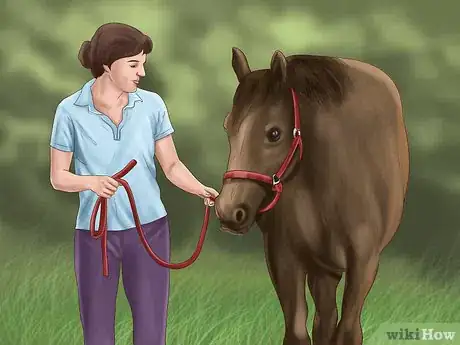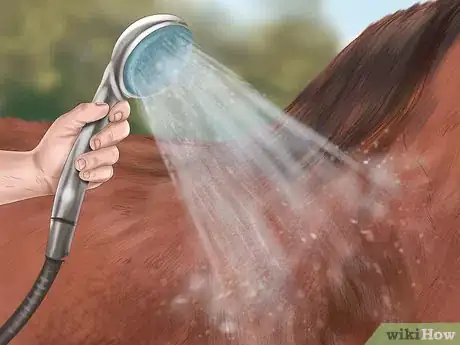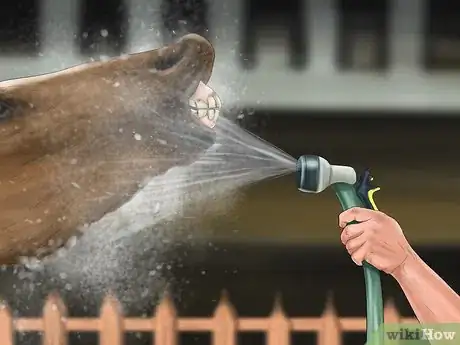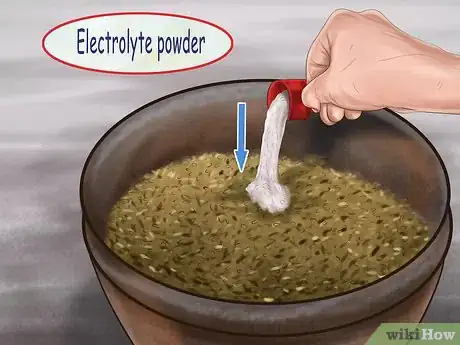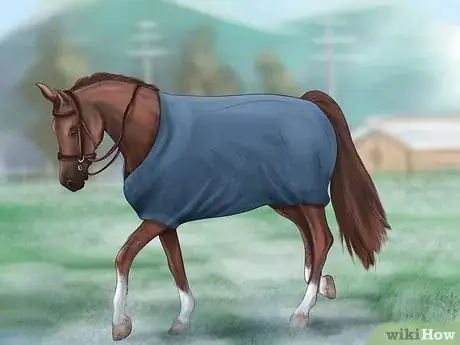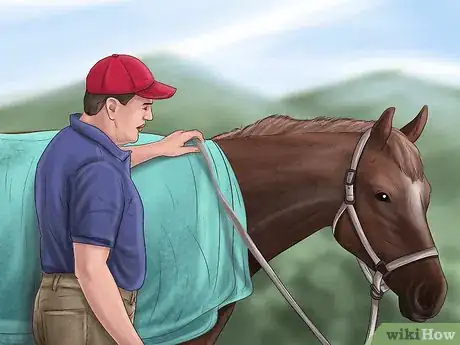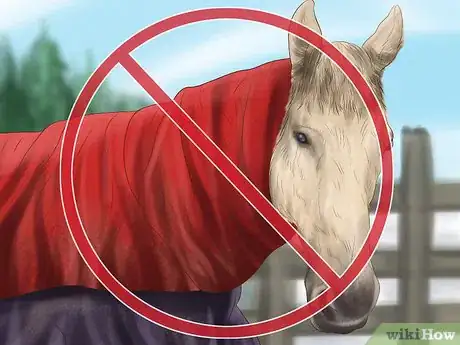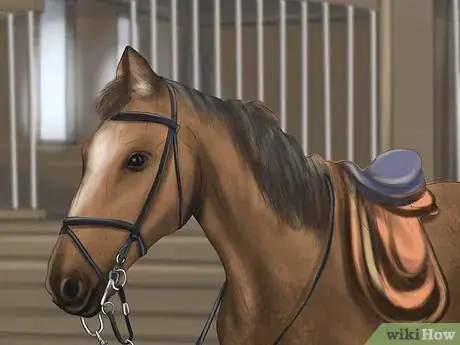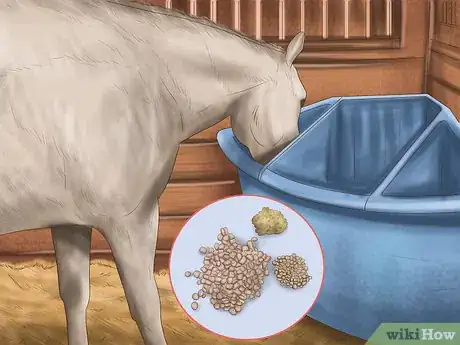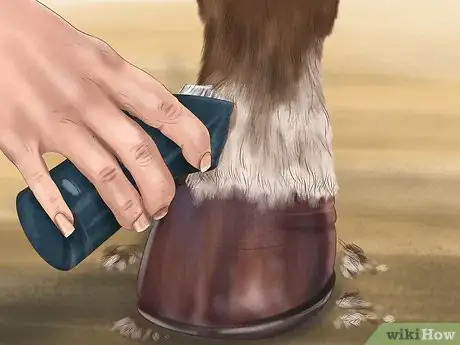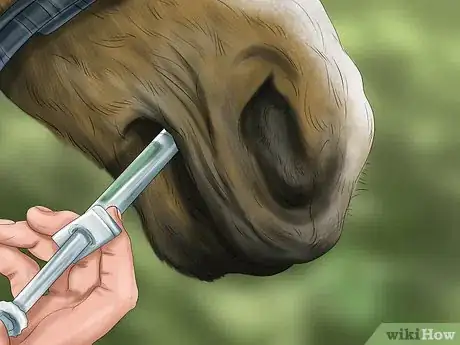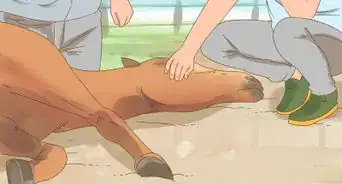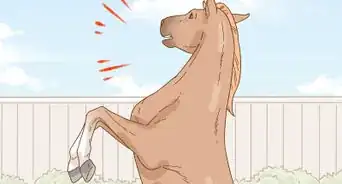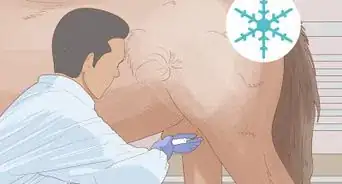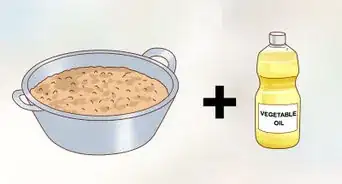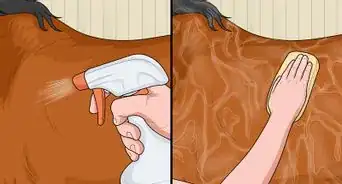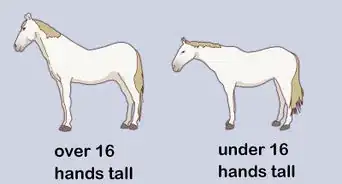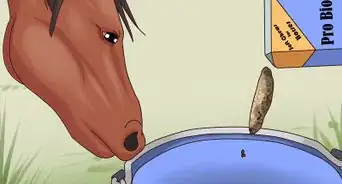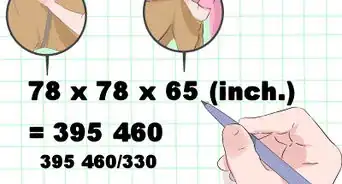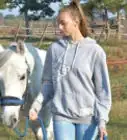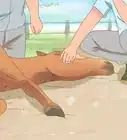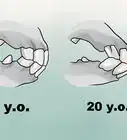This article was co-authored by Jessica Rude. Jessica Rude is an Equine Expert currently working on a cutting horse ranch in Valley View, Texas as well as a horseback riding center in Princeton, Texas. Previously, she was a Trail Guide and Wrangler at a camp and retreat center In Dallas, Texas, and an Equine Breeding Barn Manager at a reining ranch in Tioga, Texas. Jessica holds a Bachelor’s degree in Animal Science with an emphasis in Equine Science from Tarleton State University. She has studied equine nutrition, reproduction, and management. Jessica specializes in equine breeding as well as instructing horseback riding lessons, leading trail rides, recognizing equine illnesses, and administering treatments.
There are 13 references cited in this article, which can be found at the bottom of the page.
This article has been viewed 48,944 times.
Like any other athlete, a horse must warm up before exercise and cool down afterwards. In addition to getting your horse’s body temperature back down to normal, cooling off is important for relaxing its muscles and returning the horse's heart and breathing rates to normal. Although your horse’s body has natural ways to release excess heat, there will be times when it will need your help to cool down. Knowing how to cool off your horse properly will help it to recover more quickly after exercise.
Steps
Cooling Off Your Horse in the Summer
-
1Walk your horse slowly in the shade. When it’s warm outside, it is especially important to cool off your horse after a ride or workout. To start cooling down your horse, find a shady area where you can walk him at a leisurely pace. Walking helps your horse cool off by creating a small breeze and keeping his blood circulating through his muscles and skin.[1] [2]
- The blood circulation helps remove waste products, such as lactic acid, from your horse’s muscles that accumulate during exercise.[3]
- How quickly a horse cools down can depend on several factors, such as age and overall health. Although there is no set amount of time for you to walk your horse, plan to walk him for at least 10 to 15 minutes to start the cooling down process.
-
2Monitor your horse’s heart and breathing rates. Your horse’s heart and breathing rates will have gone up during exercise, so he will need some time to bring them back down to normal. While you are walking your horse, find his pulse by placing three fingers on the blood vessel that runs underneath and inside of his lower jaw. To calculate his heart rate, count his pulse for 15 seconds, then multiply by 4.[4]
- A horse’s normal heart rate is 30 to 40 beats/minute. After exercise, your horse’s heart rate could be as high as 140 to 200 beats/minute.[5]
- Watch your horse’s flank rise and fall to count the number of breaths/minute. Count the breaths for 15 seconds, then multiply by 4. Your horse normally takes 8 to 16 breaths/minute.
- Right after exercise, your horse will likely be taking big breaths, but his breaths will become more shallow as he cools off.[6] Those big breaths allow excess heat to exit through his lungs.[7]
- A breathing rate that is faster than the heart rate could signal a serious health problem.[8] Call your veterinarian if this is the case for your horse.
- Monitor your horse’s heart and breathing rates throughout the cooling off process so you know when they return to normal.
Advertisement -
3Run cold water all over your horse’s body. Your horse will naturally sweat to release excess heat. If you exercise your horse on warm days, though, sweating probably will not be enough to cool him off sufficiently. Running cold water over your horse, with either a sponge or hose, will be a tremendous help in cooling him down.[9]
- On hot days, or after a particularly vigorous workout, start with running cold water over your horse’s chest, the large jugular grooves running down his neck, and his lower legs. These areas have small blood vessels that can carry cooled blood to the rest of his body and help him cool off more quickly.[10]
- You can also hose off your horse’s large muscle groups first (e.g., back, glutes), since they tend to hold a lot of heat.[11]
- The cold water helps your horse stop sweating earlier, which can prevent him from becoming dehydrated.[12] It is a myth that hosing down a horse with cold water will harm him.[13]
- If you choose to use a sponge, you may want to have someone help you so you can sponge more of your horse’s body more quickly.
- Alternate between applying cold water for about 30 seconds and walking your horse. It is important to keep your horse moving throughout the cooling off process.[14]
- You will know your horse has cooled off sufficiently when the water running off underneath his body feels cool to the touch.[15]
-
4Mist your horse with cold water. An alternative to sponging or hosing down your horse is misting him with cold water. When moisture is absorbed from the skin with misting, that moisture takes some of your horse’s excess heat with it. If you already have a misting system set up, you can use this to cool down your horse.[16]
- You may find that frequent misting is more effective at cooling off your horse than hosing him down.[17]
- If you do not have a misting system, consider adding a nozzle to your hose that has a ‘mist’ setting.
- You may want to consider installing a sprinkler system just outside your pasture that can periodically mist your horse with cool water to keep him cool.[18]
-
5Offer frequent sips of cold water to your horse. During exercise, your horse’s digestive system slows down. The blood that would normally go to his gut to fuel digestion instead goes to his muscles. As your horse cools down, his digestion will still be on the slow side, so gulping water quickly would not be a good idea for your horse.[19]
- If he drinks water too quickly, he may develop colic or muscle cramps.[20]
- As you are walking your horse, offer him small sips of cool water from a bucket. Keep in mind that, if he’s still breathing hard, he may not be ready to drink water. Continue to offer it to him, and he will drink when he’s ready.[21]
-
6Replace your horse’s electrolytes. Although sweating will help your horse cool off, the sweat contains important electrolytes, such as salt and potassium. Electrolytes help maintain your horse’s nerve and muscle functions, so it is very important for you to replenish these electrolytes after he exercises. One way to replenish them is to give your horse a pre-formulated electrolyte paste via a dosing syringe.[22]
- Since your horse’s digestive system will still be a bit slow right after exercise, you may want to wait until he has fully cooled down before offering him the paste.
- Electrolyte powders are also available that can be added directly to your horse’s water.[23]
- Your horse may not like the taste of ‘electrolyte-laced’ water. If this is the case, offer him plain water instead.[24]
- Follow the label instructions carefully to avoid overdosing your horse on electrolytes. Speak with your veterinarian if you are unsure about the most effective way of replacing your horse’s electrolytes.
Cooling Off Your Horse in the Winter
-
1Walk your horse. Even when it’s cold outside, your horse can still work up a sweat when he exercises. His thicker winter coat will trap his body heat, though, making it harder for him to release that extra heat through sweating. After his exercise session, walk him for about 10 to 15 minutes.[25]
- Offer your horse frequent sips of water during the walk.[26]
-
2Cover your horse’s back with a cooler. A cooler is typically made of wool or fleece and helps keep your horse warm and dry as he cools off. When you dismount from your horse after your initial walk, place the cooler on his back without removing the saddle. Removing the saddle too soon would expose your horse’s back muscles to a rush of cold air and potentially cause them to cramp.[27]
-
3‘Thatch’ your horse. Thatching your horse means stuffing a thick layer of hay or straw underneath the cooler to help your horse dry off. It is useful for horses that typically take a long time to dry off after exercise. You could also use a blanket instead of a cooler.[30]
- In addition to thatching, you could rub your horse down with a clean, dry towel to dry him off more quickly.[31]
-
4Do not place multiple layers of blankets on your horse. With the cold weather, you may think you are doing your horse a favor by putting multiple blankets on him to keep him warm. Since a horse’s body temperature does not cool down as quickly as a human’s body temperature, all of those extra blankets could cause your horse’s muscle to warm up all over again. He would then start sweating again, making it take even longer for him to cool down.[32]
-
5Return your horse to his stall. Place your horse back in his stall only after he is completely dried and cooled off. Your horse could catch a chill if you return him to his stall too soon after exercise.[33] If you can still feel sweat on his body, or if his heart and breathing rates are still elevated, it is not yet time to put him back in his stall.
- If your horse is used to being covered with a blanket in the winter, cover him with a clean, warm blanket when he is completely cooled and dried off.[34]
- Call your veterinarian if your horse has not cooled down after an hour.[35] He may have an underlying medical problem that is making it harder for him to cool down.
Keeping Your Horse Cool
-
1Offer your horse plenty of fresh, cool water. In addition to cooling off your horse after he exercises, you should also make sure he stays cool during his normal, non-exercise activities in the summer. One of the best ways to do this is to give him unlimited access to fresh, cool water. The average horse can drink 50 US gal (190 l) of water a day, so you will need to replenish your horse’s water buckets frequently.[36]
- Your horse’s water intake will increase in the summer because he is losing more fluid through sweating.[37]
- Grass and commercial diets typically provide most of your horse’s water requirements, but he will still need access to fresh water at all times.
- Although it may be tempting to set some buckets out in the pasture when your horse is grazing, the water can warm up and even become stagnant.[38] You may want to keep the buckets in a cool, shaded area when your horse is out of his stall. Keep buckets of fresh water in his stall as well.[39]
-
2Turnout your horse when it’s cool outside. During the summer, it would be too hot to turnout your horse during the heat of the day. Instead, pick times of day that are cooler, such as the early morning or after the sun has set. If possible, consider turning out your horse overnight.[40]
-
3Clip your horse’s coat. If your horse has a thick coat, he will have a hard time keeping cool when it is warm outside. His thick coat will trap in heat and make it harder for him to release excess heat through sweating. Keeping a short coat is especially important for horses with Cushing’s disease, since this disease can cause a horse to develop a long, thick coat.[43] [44]
- Do not make your horse’s coat too short, since his coat protects him from the damage of the sun’s rays.[45]
- Consult with your veterinarian if you are unsure about the particular coat thickness that would best suit your horse.
-
4Keep your horse healthy. Your horse’s health can affect his ability to regulate his body temperature effectively. For example, intestinal parasites can increase your horse’s likelihood of developing heat exhaustion. In general, if your horse is sick or injured, he may not have enough internal energy to use his natural methods of cooling off.[46]
- Maintain your horse’s deworming schedule to keep his intestinal parasite burden low.[47]
- If your horse has a chronic illness like Cushing’s disease, manage his disease according to your veterinarian’s recommendations. The better you manage his disease, the better he may be able to keep cool when it’s warm outside.
-
5Recognize the signs of heatstroke. Heatstroke occurs when your horse’s natural cooling systems cannot overcome his body’s excess heat. It is a very serious medical condition that requires immediate veterinary care. The sooner you can recognize the signs of heatstroke, the sooner you can get him the care he needs.[48]
- With heatstroke, your horse will be sweating profusely, or not sweating at all. In addition, his heart rate will remain elevated even after he has had sufficient time to cool off.[49]
- Your horse will also look very depressed and lethargic if he has heatstroke.[50]
- If you examine your horse’s gums, they will feel dry and sticky to the touch. The capillary refill time (the amount of time it takes for his gums to turn pink after you press on them) will be greater than three seconds.[51]
- Horses with heatstroke will have a temperature above 106 degrees F/41 degrees C.[52]
Expert Q&A
Did you know you can get expert answers for this article?
Unlock expert answers by supporting wikiHow
-
QuestionHow can I keep my horse cool when it's hot out?
 Jessica RudeJessica Rude is an Equine Expert currently working on a cutting horse ranch in Valley View, Texas as well as a horseback riding center in Princeton, Texas. Previously, she was a Trail Guide and Wrangler at a camp and retreat center In Dallas, Texas, and an Equine Breeding Barn Manager at a reining ranch in Tioga, Texas. Jessica holds a Bachelor’s degree in Animal Science with an emphasis in Equine Science from Tarleton State University. She has studied equine nutrition, reproduction, and management. Jessica specializes in equine breeding as well as instructing horseback riding lessons, leading trail rides, recognizing equine illnesses, and administering treatments.
Jessica RudeJessica Rude is an Equine Expert currently working on a cutting horse ranch in Valley View, Texas as well as a horseback riding center in Princeton, Texas. Previously, she was a Trail Guide and Wrangler at a camp and retreat center In Dallas, Texas, and an Equine Breeding Barn Manager at a reining ranch in Tioga, Texas. Jessica holds a Bachelor’s degree in Animal Science with an emphasis in Equine Science from Tarleton State University. She has studied equine nutrition, reproduction, and management. Jessica specializes in equine breeding as well as instructing horseback riding lessons, leading trail rides, recognizing equine illnesses, and administering treatments.
Equine Expert
-
QuestionHow long does it take to cool down a hot horse?
 Community AnswerIt shouldn't take too long, but it all depends on how hot he is. Walking a horse is a good and effective idea.
Community AnswerIt shouldn't take too long, but it all depends on how hot he is. Walking a horse is a good and effective idea. -
QuestionHow do I go into a gallop from a canter?
 Community AnswerYou should allow your horse a little more head (loosen your reins). Sit deep into your saddle and watch your canter lead. Start with a voice command, and if it doesn't work, try applying pressure through your heels slightly. Keep applying a little more pressure each time until you can feel his stride becoming longer and faster (he is preparing to gallop). Eventually he will transition smoothly with consistent practice and correct training.
Community AnswerYou should allow your horse a little more head (loosen your reins). Sit deep into your saddle and watch your canter lead. Start with a voice command, and if it doesn't work, try applying pressure through your heels slightly. Keep applying a little more pressure each time until you can feel his stride becoming longer and faster (he is preparing to gallop). Eventually he will transition smoothly with consistent practice and correct training.
Warnings
- Ice can constrict your horse’s blood vessels, causing him to feel pain and discomfort.[59] Do not use ice to cool him off.⧼thumbs_response⧽
- If you do not keep your horse moving after exercise, the blood can accumulate in the dilated blood vessels in his legs.[60]⧼thumbs_response⧽
- A horse that is not properly cooled down can experience muscle damage and laminitis (inflammation in the hoof).[61]⧼thumbs_response⧽
- An overheated horse can experience weakness, colic, and organ damage.[62]⧼thumbs_response⧽
- Heatstroke can be fatal in horses.[63]⧼thumbs_response⧽
References
- ↑ http://trailridermag.com/article/six-cool-down-strategies-for-your-horse-20190
- ↑ http://horsetalk.co.nz/health/cooling-134.shtml#axzz42FkYZAdC
- ↑ http://horsetalk.co.nz/health/cooling-134.shtml#axzz42FkYZAdC
- ↑ http://horsetalk.co.nz/health/cooling-134.shtml#axzz42FkYZAdC
- ↑ http://horsetalk.co.nz/health/cooling-134.shtml#axzz42FkYZAdC
- ↑ http://horsetalk.co.nz/health/cooling-134.shtml#axzz42FkYZAdC
- ↑ http://trailridermag.com/article/six-cool-down-strategies-for-your-horse-20190
- ↑ http://horsetalk.co.nz/health/cooling-134.shtml#axzz42FkYZAdC
- ↑ Jessica Rude. Equine Expert. Expert Interview. 18 September 2020.
- ↑ http://www.equisearch.com/article/keep-your-horse-cool-heat-18958
- ↑ http://horsetalk.co.nz/health/cooling-134.shtml#axzz42FkYZAdC
- ↑ http://horsetalk.co.nz/health/cooling-134.shtml#axzz42FkYZAdC
- ↑ http://trailridermag.com/article/six-cool-down-strategies-for-your-horse-20190
- ↑ http://horsetalk.co.nz/health/cooling-134.shtml#axzz42FkYZAdC
- ↑ http://www.equisearch.com/article/keep-your-horse-cool-heat-18958
- ↑ http://www.thehorse.com/articles/29338/10-hot-weather-horse-care-tips
- ↑ http://www.thehorse.com/articles/29338/10-hot-weather-horse-care-tips
- ↑ http://www.equisearch.com/article/keep-your-horse-cool-heat-18958
- ↑ http://horsetalk.co.nz/health/cooling-134.shtml#axzz42FkYZAdC
- ↑ http://horsetalk.co.nz/health/cooling-134.shtml#axzz42FkYZAdC
- ↑ http://www.equisearch.com/article/keep-your-horse-cool-heat-18958
- ↑ http://www.thehorse.com/articles/10205/fluids-and-electrolytes
- ↑ http://www.barrelhorsenews.com/articles/horse-health/3508
- ↑ http://www.thehorse.com/articles/29338/10-/hot-weather-horse-care-tips
- ↑ http://equusmagazine.com/article/coolingout-10486
- ↑ http://equusmagazine.com/article/coolingout-10486
- ↑ http://equusmagazine.com/article/coolingout-10486
- ↑ http://equusmagazine.com/article/coolingout-10486
- ↑ http://equusmagazine.com/article/coolingout-10486
- ↑ http://equusmagazine.com/article/coolingout-10486
- ↑ http://equusmagazine.com/article/coolingout-10486
- ↑ http://practicalhorsemanmag.com/article/dry-your-damp-horse-in-winter-11779
- ↑ http://equusmagazine.com/article/coolingout-10486
- ↑ http://equusmagazine.com/article/coolingout-10486
- ↑ http://equusmagazine.com/article/coolingout-10486
- ↑ Jessica Rude. Equine Expert. Expert Interview. 18 September 2020.
- ↑ http://www.thehorse.com/articles/10205/fluids-and-electrolytes
- ↑ http://www.thehorse.com/articles/29338/10-hot-weather-horse-care-tips
- ↑ http://www.thehorse.com/articles/10205/fluids-and-electrolytes
- ↑ http://www.thehorse.com/articles/29338/10-hot-weather-horse-care-tips
- ↑ Jessica Rude. Equine Expert. Expert Interview. 18 September 2020.
- ↑ Jessica Rude. Equine Expert. Expert Interview. 18 September 2020.
- ↑ http://www.thehorse.com/articles/29338/10-hot-weather-horse-care-tips
- ↑ http://www.petmd.com/horse/conditions/endocrine/c_hr_cushings_syndrome/
- ↑ http://www.thehorse.com/articles/29338/10-hot-weather-horse-care-tips
- ↑ http://www.drsfostersmith.com/pic/article.cfm?aid=1833
- ↑ http://www.drsfostersmith.com/pic/article.cfm?aid=1833
- ↑ http://www.thehorse.com/articles/29338/10-hot-weather-horse-care-tips
- ↑ http://www.thehorse.com/articles/29338/10-hot-weather-horse-care-tips
- ↑ http://www.thehorse.com/articles/29338/10-hot-weather-horse-care-tips
- ↑ http://veterinaryteam.dvm360.com/protect-horses-heat-exhaustion-and-heat-stroke
- ↑ http://veterinaryteam.dvm360.com/protect-horses-heat-exhaustion-and-heat-stroke
- ↑ http://trailridermag.com/article/six-cool-down-strategies-for-your-horse-20190
- ↑ http://horsetalk.co.nz/health/cooling-134.shtml#axzz42FkYZAdC
- ↑ http://www.thehorse.com/articles/10205/fluids-and-electrolytes
- ↑ http://www.equisearch.com/article/keep-your-horse-cool-heat-18958
- ↑ http://www.equisearch.com/article/keep-your-horse-cool-heat-18958
- ↑ http://www.drsfostersmith.com/pic/article.cfm?aid=1833
- ↑ http://horsetalk.co.nz/health/cooling-134.shtml#axzz42FkYZAdC
- ↑ http://horsetalk.co.nz/health/cooling-134.shtml#axzz42FkYZAdC
- ↑ http://horsetalk.co.nz/health/cooling-134.shtml#axzz42FkYZAdC
- ↑ http://trailridermag.com/article/six-cool-down-strategies-for-your-horse-20190
- ↑ http://trailridermag.com/article/six-cool-down-strategies-for-your-horse-20190
About This Article
You can cool your horse by walking it in the shade for 10-15 minutes after exercising, which will increase its circulation to help cool its body. On particularly hot days, use a sponge or hose to douse your horse in cold water after a workout, which will stop it from sweating too much and becoming dehydrated. Make sure to offer your horse sips of cold water both during and after exercise so that it stays hydrated and doesn’t overheat. However, don’t let your horse drink too quickly, as this can cause muscle cramps. To learn how to recognize the signs of heatstroke in your horse, read more from our Veterinary co-author.
